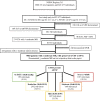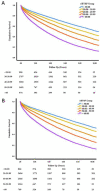Prevalence of pulmonary hypertension in mitral regurgitation and its influence on outcomes
- PMID: 37280015
- PMCID: PMC10254941
- DOI: 10.1136/openhrt-2023-002268
Prevalence of pulmonary hypertension in mitral regurgitation and its influence on outcomes
Abstract
Objective: Pulmonary hypertension (PHT) commonly coexists with significant mitral regurgitation (MR), but its prevalence and prognostic importance have not been well characterised. In a large cohort of adults with moderate or greater MR, we aimed to describe the prevalence and severity of PHT and assess its influence on outcomes.
Methods: In this retrospective study, we analysed the National Echocardiography Database of Australia (data from 2000 to 2019). Adults with an estimated right ventricular systolic pressure (eRVSP), left ventricular ejection fraction >50% and with moderate or greater MR were included (n=9683). These subjects were then categorised according to their eRVSP. The relationship between PHT severity and mortality outcomes was evaluated (median follow-up of 3.2 years, IQR 1.3-6.2 years).
Results: Subjects were aged 76±12 years, and 62.6% (6038) were women. Overall, 959 (9.9%) had no PHT, and 2952 (30.5%), 3167 (32.7%), 1588 (16.4%) and 1017 (10.5%) patients had borderline, mild, moderate and severe PHT, respectively. A 'typical left heart disease' phenotype was identified with worsening PHT, showing rising E:e', right and left atrial sizes increasing progressively, from no PHT to severe PHT (p<0.0001, for all). With increasing PHT severity, 1- and 5-year actuarial mortality increased from 8.5% and 33.0% to 39.7% and 79.8%, respectively (p<0.0001). Similarly, adjusted survival analysis showed the risk of long-term mortality progressively increased with higher eRVSP levels (adjusted HR 1.20-2.86, borderline to severe PHT, p<0.0001 for all). A mortality inflection was apparent at an eRVSP level >34.00 mm Hg (HR 1.27, CI 1.00-1.36).
Conclusions: In this large study, we report on the importance of PHT in patients with MR. Mortality increases as PHT becomes more severe from an eRVSP of 34 mm Hg onwards.
Keywords: heart valve diseases; hypertension, pulmonary; mitral valve insufficiency.
© Author(s) (or their employer(s)) 2023. Re-use permitted under CC BY-NC. No commercial re-use. See rights and permissions. Published by BMJ.
Conflict of interest statement
Competing interests: SS, DP and GS have previously received consultancy/speaking fees from Edwards Lifesciences. DP and GS have received consultancy fees from Medtronic, Edwards Lifesciences, Abbott Laboratories and ECHO IQ Pty Ltd.
Figures



Similar articles
-
Prevalence of pulmonary hypertension in aortic stenosis and its influence on outcomes.Heart. 2023 Aug 11;109(17):1319-1326. doi: 10.1136/heartjnl-2022-322184. Heart. 2023. PMID: 37012043
-
Prevalence of pulmonary hypertension in aortic regurgitation and its influence on outcomes.Heart. 2023 Aug 11;109(17):1310-1318. doi: 10.1136/heartjnl-2022-322187. Heart. 2023. PMID: 37012044
-
Negative impact of atrial fibrillation and pulmonary hypertension after mitral valve surgery in asymptomatic patients with severe mitral regurgitation: a 20-year follow-up.Eur J Cardiothorac Surg. 2015 Oct;48(4):548-55; discussion 555-6. doi: 10.1093/ejcts/ezu511. Epub 2015 Jan 5. Eur J Cardiothorac Surg. 2015. PMID: 25564214
-
Prevalence and prognostic significance of pulmonary hypertension in adults with left ventricular diastolic dysfunction.Open Heart. 2024 Dec 3;11(2):e003049. doi: 10.1136/openhrt-2024-003049. Open Heart. 2024. PMID: 39627022 Free PMC article.
-
Threshold of Pulmonary Hypertension Associated With Increased Mortality.J Am Coll Cardiol. 2019 Jun 4;73(21):2660-2672. doi: 10.1016/j.jacc.2019.03.482. J Am Coll Cardiol. 2019. PMID: 31146810
Cited by
-
Current trends and latest developments in echocardiographic assessment of right ventricular function: load dependency perspective.Front Cardiovasc Med. 2024 Jul 1;11:1365798. doi: 10.3389/fcvm.2024.1365798. eCollection 2024. Front Cardiovasc Med. 2024. PMID: 39011493 Free PMC article. Review.
-
Exercise Pulmonary Hypertension in Heart Valve Disease.Rev Cardiovasc Med. 2024 Apr 2;25(4):131. doi: 10.31083/j.rcm2504131. eCollection 2024 Apr. Rev Cardiovasc Med. 2024. PMID: 39076551 Free PMC article. Review.
-
Mortality associated with moderate and severe mitral regurgitation in 608 570 men and women undergoing echocardiography.Heart. 2025 Mar 13;111(7):327-334. doi: 10.1136/heartjnl-2024-324790. Heart. 2025. PMID: 39706686 Free PMC article.
-
Characteristics of pulmonary hypertension in adults with left ventricular diastolic dysfunction.Open Heart. 2025 Apr 2;12(1):e003174. doi: 10.1136/openhrt-2025-003174. Open Heart. 2025. PMID: 40175099 Free PMC article.
-
Pulmonary Hypertension in Left Ventricular Valvular Diseases: A Comprehensive Review on Pathophysiology and Prognostic Value.Life (Basel). 2023 Aug 22;13(9):1793. doi: 10.3390/life13091793. Life (Basel). 2023. PMID: 37763197 Free PMC article. Review.
References
Publication types
MeSH terms
LinkOut - more resources
Full Text Sources
Medical
